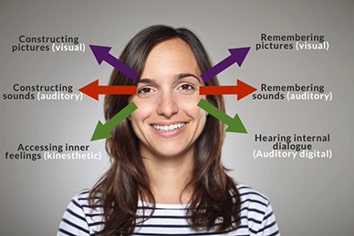Eye Accessing Cues
Eye Accessing Cues in NLP Are Movements of the eyes in certain directions that indicate visual, auditory or kinaesthetic thinking.
Neuro Linguistic Programming (nlp) teaches us that people make movements with their eyes (Eye Accessing Cues) that will indicate which representational system they are using. It is said that we all go inside and access information by eye movement, and people store information in a certain way so that they use their eyes to locate the information either visually, auditorally, or kinaesthetically. When you ask someone a question, you may have noticed their eyes move, using a skill trained in a nlp practitioner course we can determine which representational system a person is accessing by the way they move their eyes. In addition, people may move their bodies to indicate in which quadrant of their brain they are searching to locate information.

The Eye Accessing Cues are presented in what is called a Normally Organised pattern. This has nothing to do with being normal; it is merely terminology that indicates what you will find in the majority of the people you meet. Follow the chart below. For those who don’t, it is called Reverse Organised, a reversed cerebral organisation.
There is no right or wrong way. There is only the way that your clients, customers or friends and family store information. There is some, but no proven correlation between right and left-handedness and normal and reverse organisation.
In order to determine whether a person is normally or reverse organised you ask them questions and watch which way their eyes move.
In the case of working with clients in a therapeutic environment, you can begin immediately to determine their organisation through the questions you ask during the Client Profile or the Outcome Achievement Steps of the initial part of the interview.
Some individuals look through several or all the representational systems for the same piece of information. When this is done, it is called a Transderivational Search. Also some clients may have what I call a “look to talk” rule and will make minimal or no eye movement.
It is known that different areas of the brain are resposible for different aspects of representation.

The six areas the eyes will go to, to find information are;
- visual remembered (top right as you are looking at them);
- audio remembered (middle right as you look at them);
- self talk, or calculations(lower right as you look at them);
- visual constructed (top left as you look at them);
- audio construct (middle left as you look at them);
- tactile (lower left as you look at them).

